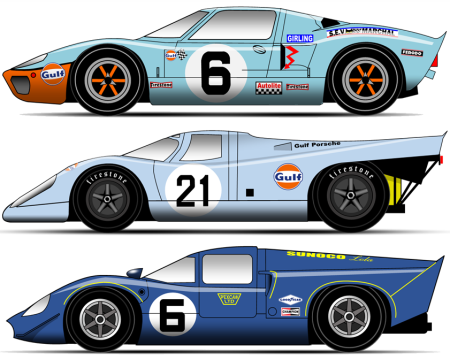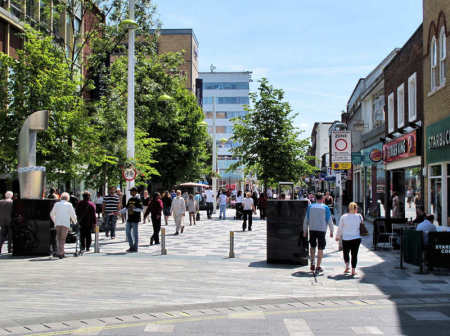
Introduction to Slough
Come, friendly bombs, and fall on Slough
It isn't fit for humans now
There isn't grass to graze a cow
Swarm over, Death!
In 1937, with the outbreak of the Second World War imminent, Betjeman wrote his infamous poem Slough. By coincidence, that very same year, the first Hawker Hurricane fighters came off the production line at Langley which is now part of Slough.
This was ironic because during the Battle of Britain, the Hawker Hurricane shot down more enemy aircraft, especially bombers, than all other forms of defence put together thus preventing many bombs, friendly or otherwise, falling on towns and cities across the whole country.
Hawker Hurricane I
To be fair to Betjeman he was, in an inept way, trying to attack the industrialisation of Slough in the inter-war years. Because of his ineptitude in delivering the words his message has been misunderstood. In the meantime, the industrialisation of Slough has led to it becoming the commercially successful town that it is today.
According to the Business Review Berkshire, October 2014, Slough is second only to London in the UK of towns where new businesses are created. The statistics are based on the number of new businesses created per 10,000 of the population in a given year. Slough scored 15·5 new business per 10,000 population in 2012. London came first with a score of 16 and third was Milton Keynes with a score of 10·5.
Source: Business Review Berkshire, October 2014
Slough Trading Estate is Europe’s largest such estate in single private ownership and has come to define modern Slough and several multi-national companies have based their head offices here. Here’s what the Slough Chamber of Commerce has to say about the town:
‘The Slough Chamber of Commerce is the largest of eight Chambers which cover the Thames Valley Region.
Slough has a thriving £25 billion economy and ambitious, confident plans for the future.
Slough is one of the top three most productive towns in the UK outside of London and we’re home to some of the best known names in business including Amazon, Honda, Research in Motion, O2 and Mars.
Companies like these choose to locate in Slough because of the transport links, the plentiful supply of talent and the excellent infrastructure and networks in the area. And we are delighted to welcome them.’
Source: Thames Valley Chamber of Commerce website 2014
In January 2015, four schools in Slough Borough Council were rated in the top 100 out of over 3,100 secondary schools in the country by the Department of Education for GCSE results.
The rankings were based on the number the number of students who achieved at least A* to C grades in GCSE subjects that included English and Maths. The schools concerned were:
- Langley Grammar which was ranked 29th or, expressed another way, within the top 1 per cent of the country
- Herschel Grammar ranked 77th
- St Bernard’s 82nd
- Upton Grammar 85th
The TV series Thunderbirds, Stingray and Captain Scarlet were produced in Slough
The first Ford Transits and the Ford GT40, four times winner of the Le Mans 24 hour race, were built in Slough. Other successful motor racing teams have been based here such as McLaren, Lola, Surtees and JWAE Gulf who redesigned a version of the disappointing Porsche 917 to turn it into a world beating race car.
Ford GT40 and Porsche 917K both won the Le Mans 24 hour and the Lola T70 won at the Daytona 24 hour
Slough has a population of over 140,000. The town centre has two indoor shopping centres and there are more than 300 shops, restaurants and pubs. The diverse cultures of the town offer an exciting mix and range of restaurants to satisfy pretty much any palette.
The busy High Street is pedestrianized
Slough is well positioned for communications and travel. The Great Western Railway provides links to London, the South West and South Wales. The M4 motorway parallels the railway and links to the nearby M25 and the M40 links to Birmingham, the North, North Wales and Scotland. London Heathrow Airport lies just to the east and offers flights around the world.
The unique and ornate Grade II listed station buildings were designed by John Danks and opened in 1884.
For quality of life, Slough has over 60 public parks and open spaces in the town, all well-presented and well maintained. At the time of writing, four of Slough’s parks had Green Flag awards.
About 3 miles of the Jubilee River lies within the town’s boundaries including Dorney Wetlands, which is becoming an important area for wildlife. Some surprising wildlife thrive here including red kite, little egret, muntjac deer and ring-necked parakeet.
The Jubilee River from Wood Lane Bridge
Close to the town centre is tranquil Herschel Park surrounded by the Victorian houses of Upton Park; The Mere which was the home of Charles Dickens’ publisher, Bentleys; St Laurence’s Church, the oldest building in Slough and resting place of astronomer Sir William Herschel who lived and worked in the town.
Great crested grebe
Compared to its neighbours Eton and Windsor, Slough hasn’t many listed buildings. This is because before the First World War the area we now know as Slough was a series of small villages centred around old coaching inns on the London to Bath Road. However, much of the older parts of Eton College were built from bricks made in Slough.
The Ostrich Inn in Colnbrook is credited with being the third oldest pub in England and is said to have been the site of some sixty murders by its landlord in mediaeval times.
My name is Gary Flint. I'm author, photographer & illustrator for Postcards from Slough. If you wish to make any comments on the contents of the website please click on the ladybird below:
Gary Flint
08/03/1961 - 09/04/2019
Postcards from Slough is an independently funded website. We are open to offers of sponsorship from companies that have any connections to the town. To contact us please click on the ladybird below:
Chalvey Community Forum
Postcards from Slough is linked with a local action group the Chalvey Community Forum. The group liaises with various local organisations in order to improve the quality of life for residents in the ward of Chalvey and Salt Hill. To learn more please click on the maidenhair leaf below:
Museum of Berkshire Aviation
I volunteer as a guide at the Museum of Berkshire Aviation. It is a special museum and if you would like to know more about the museum then please click on the motif below:
To learn more about the museums activities while staying within this website click on the tab at the top of the page or on the motif below:
Graces Guide
Postcards from Slough uses some images from Grace's Guide. Click on the button below:
British Listed Buildings
Postcards from Slough contributes material to British Listed Buildings and uses the site for cross referencing purposes. Click on the button below:














